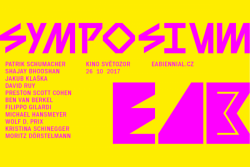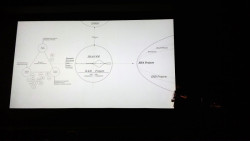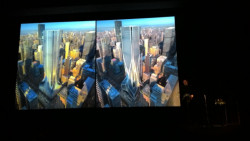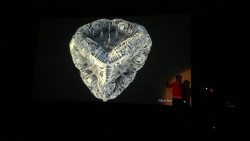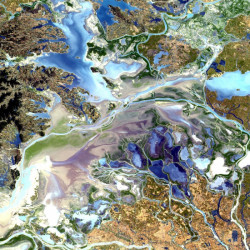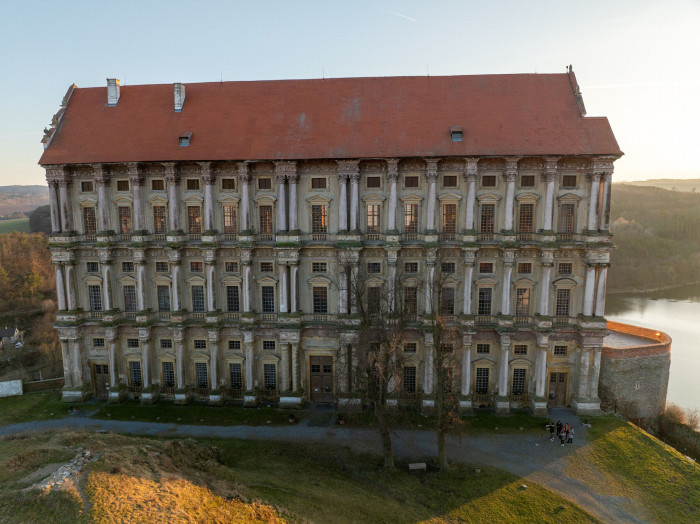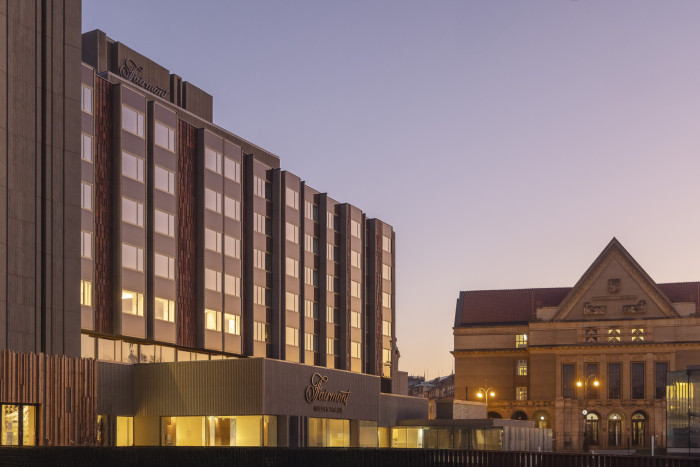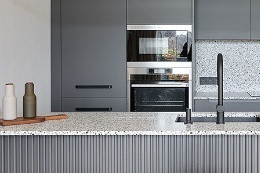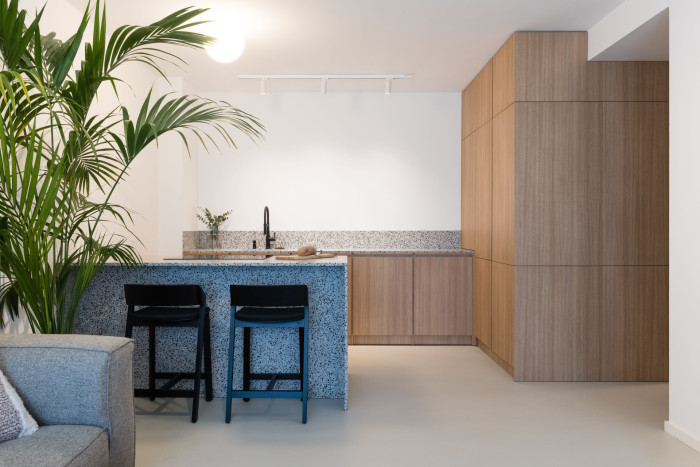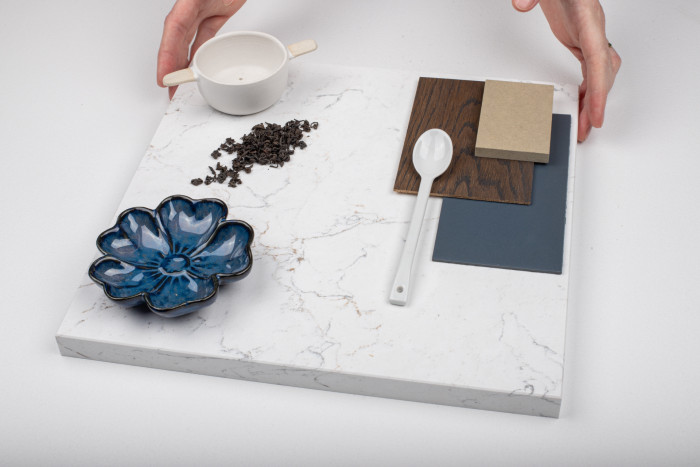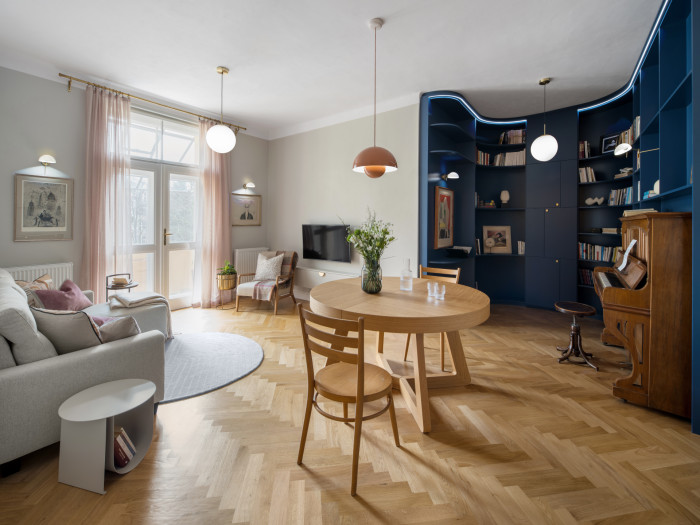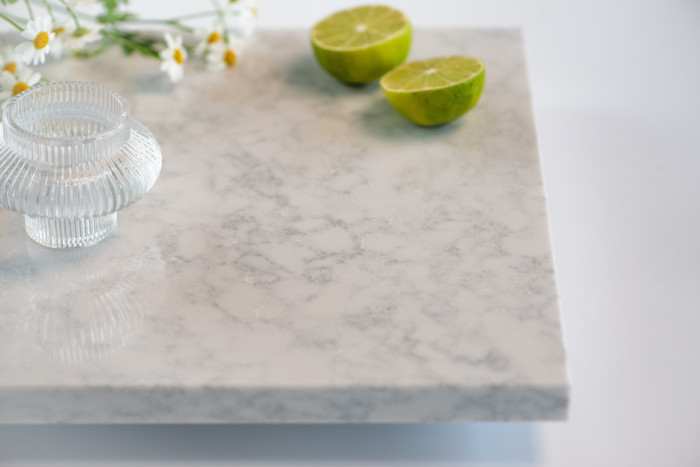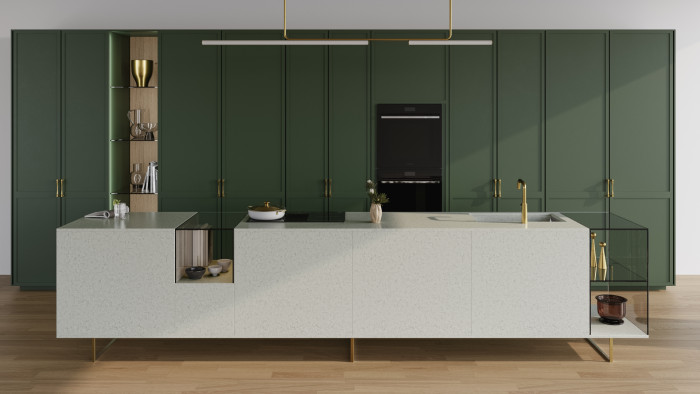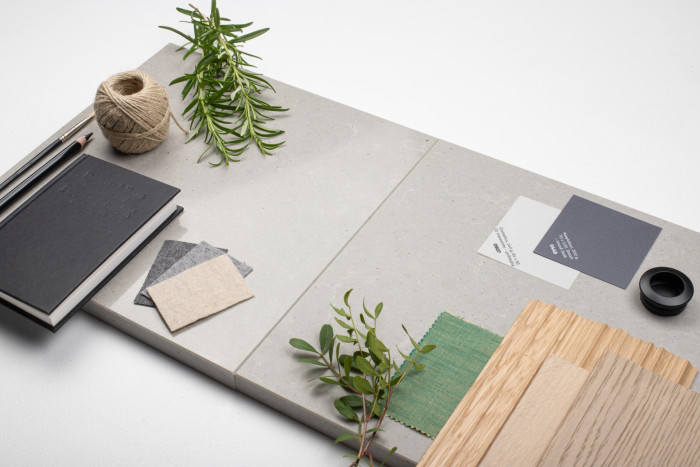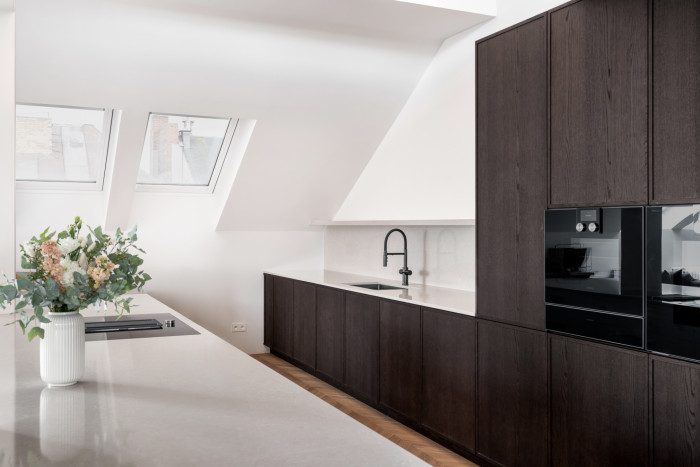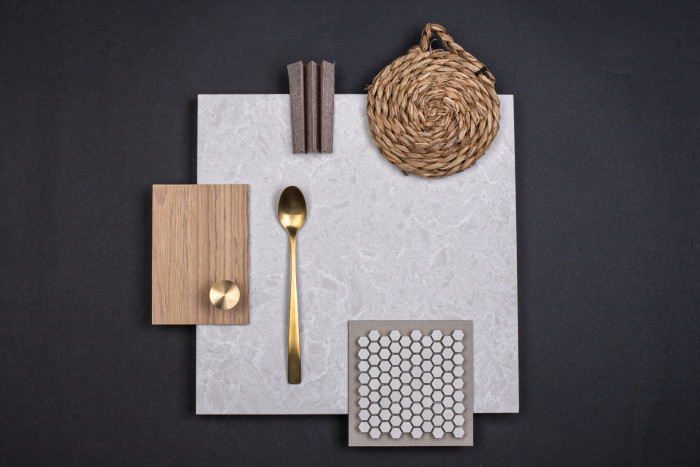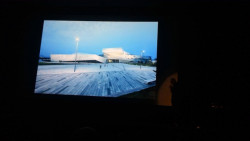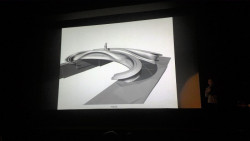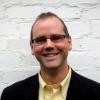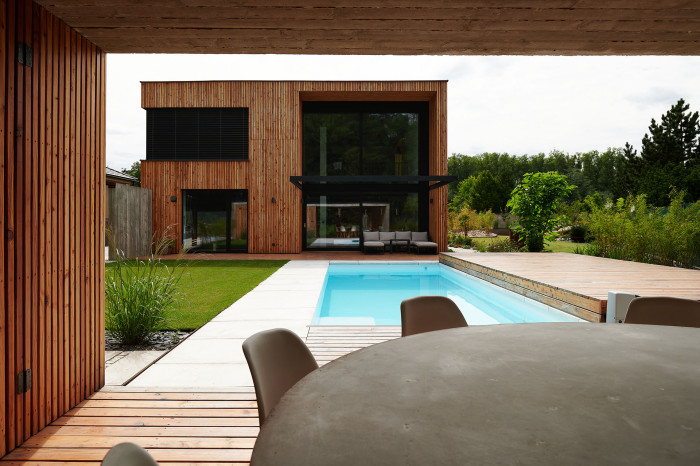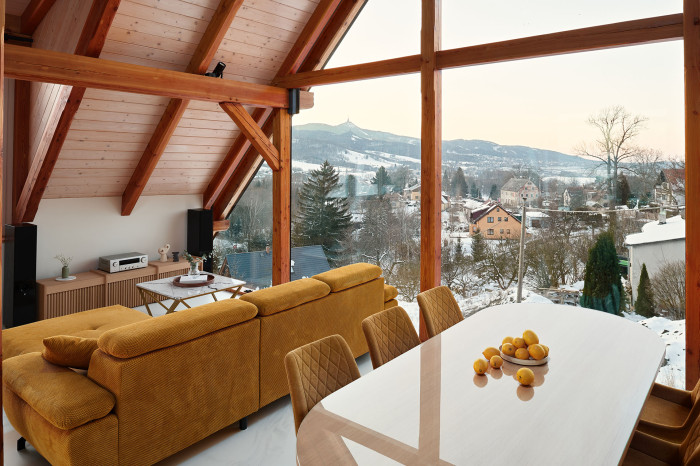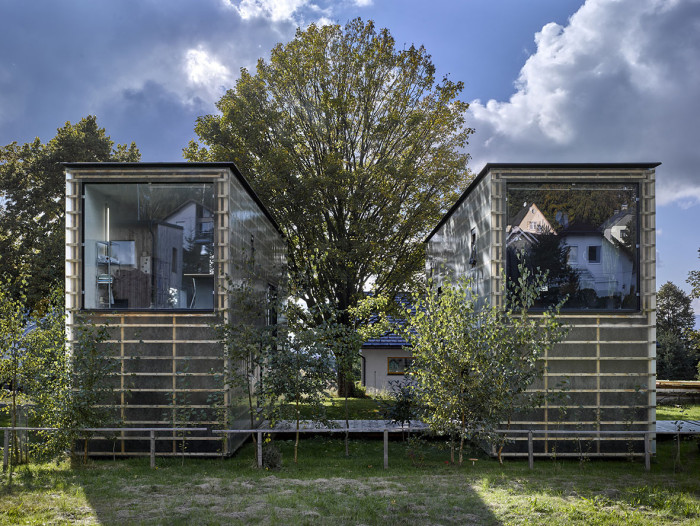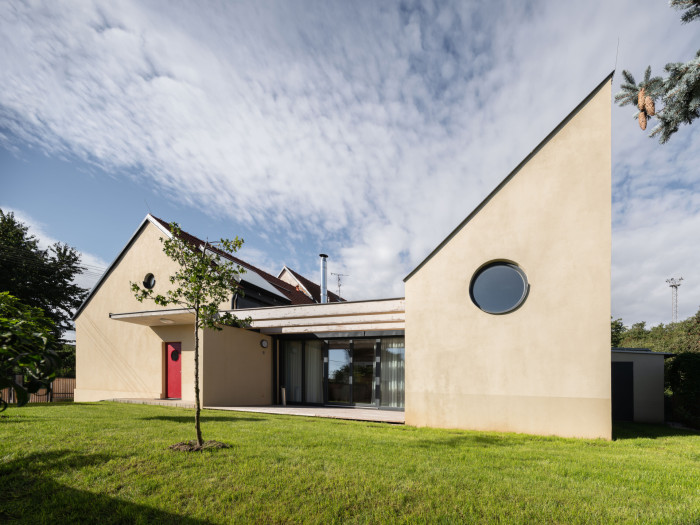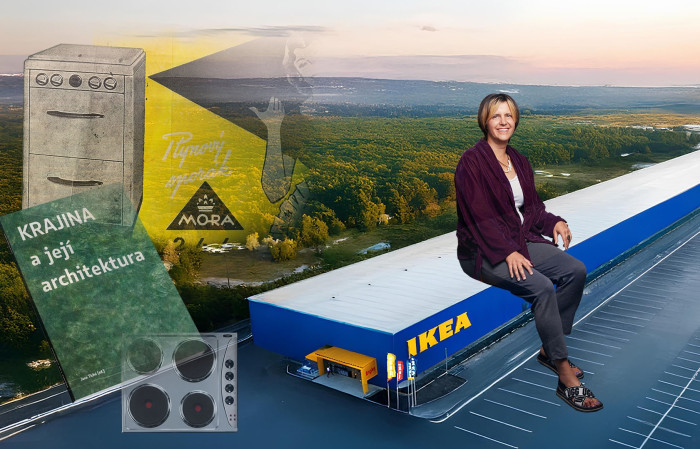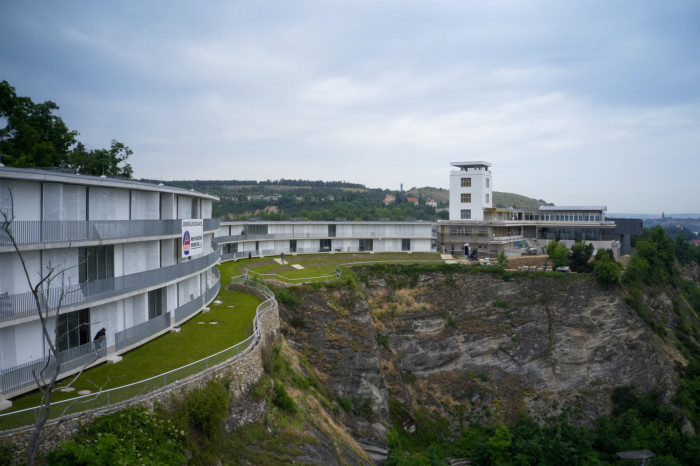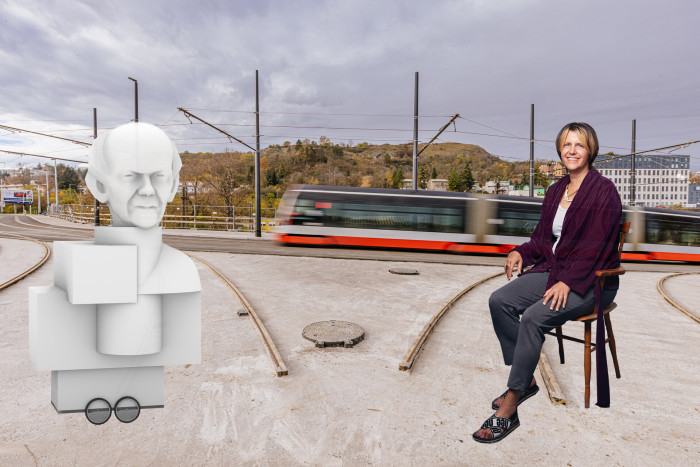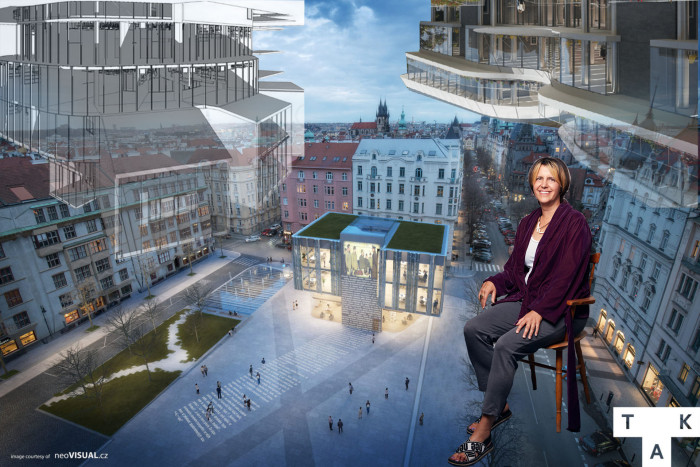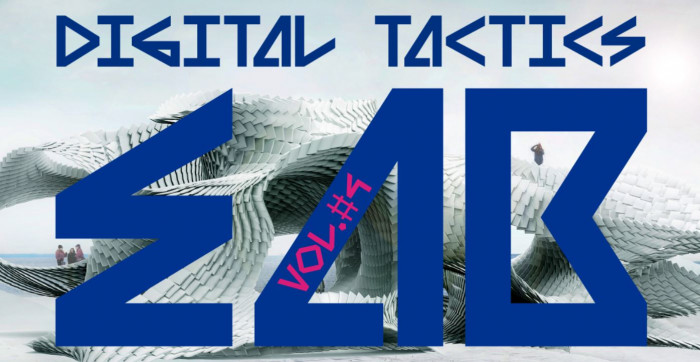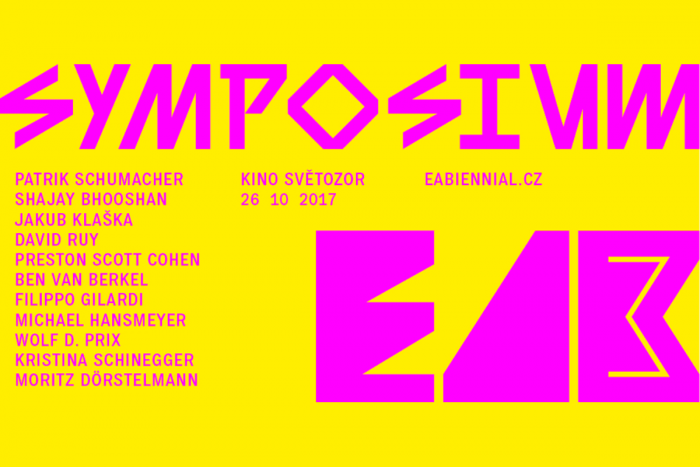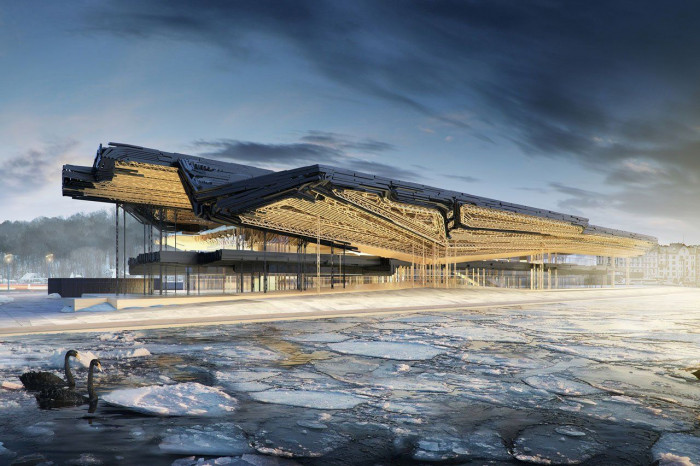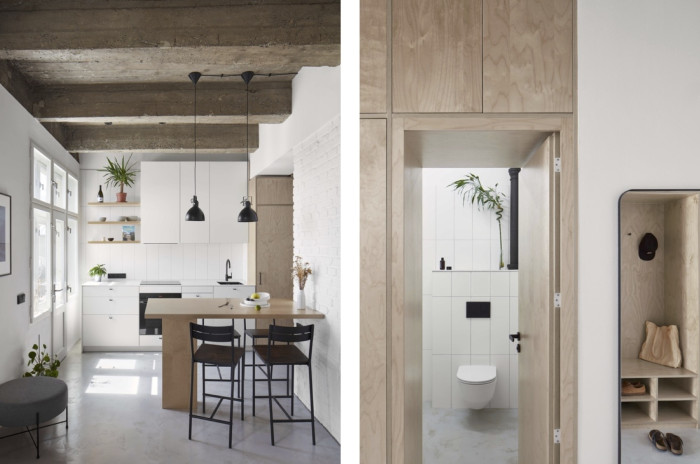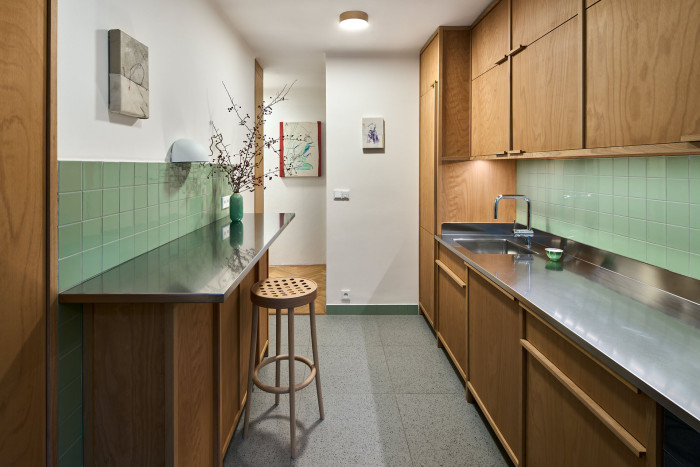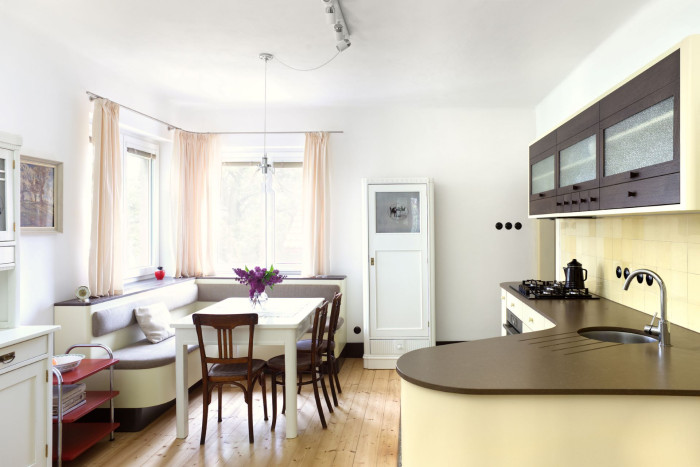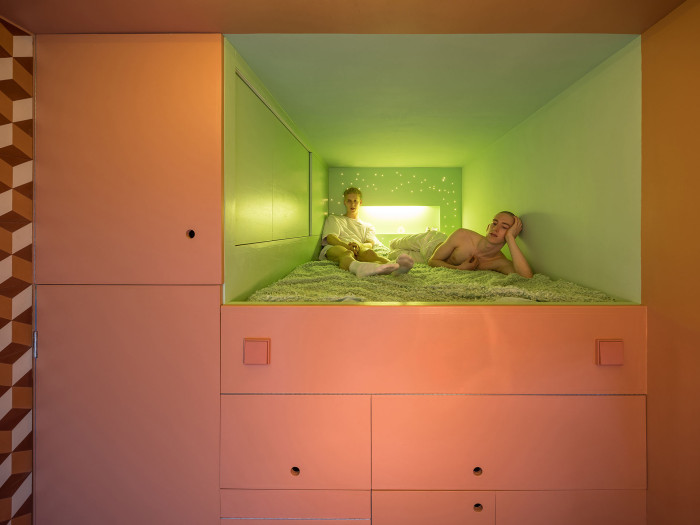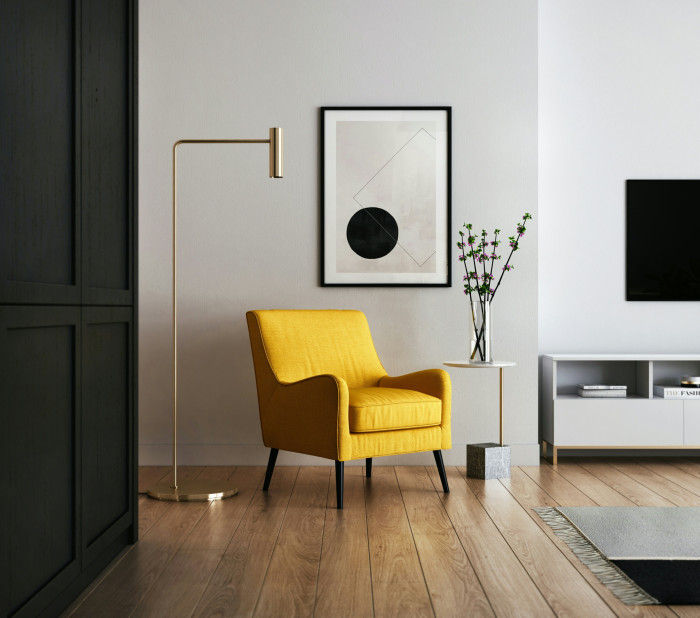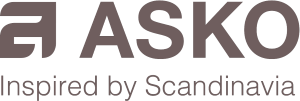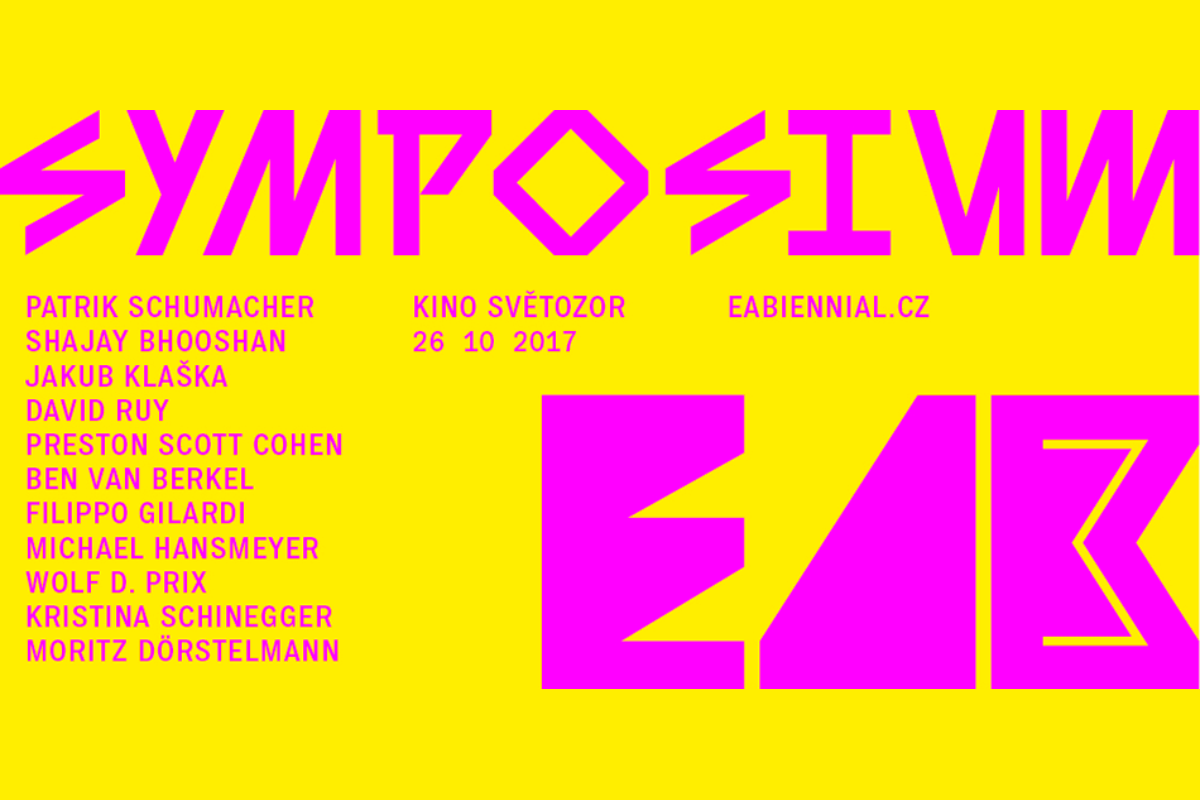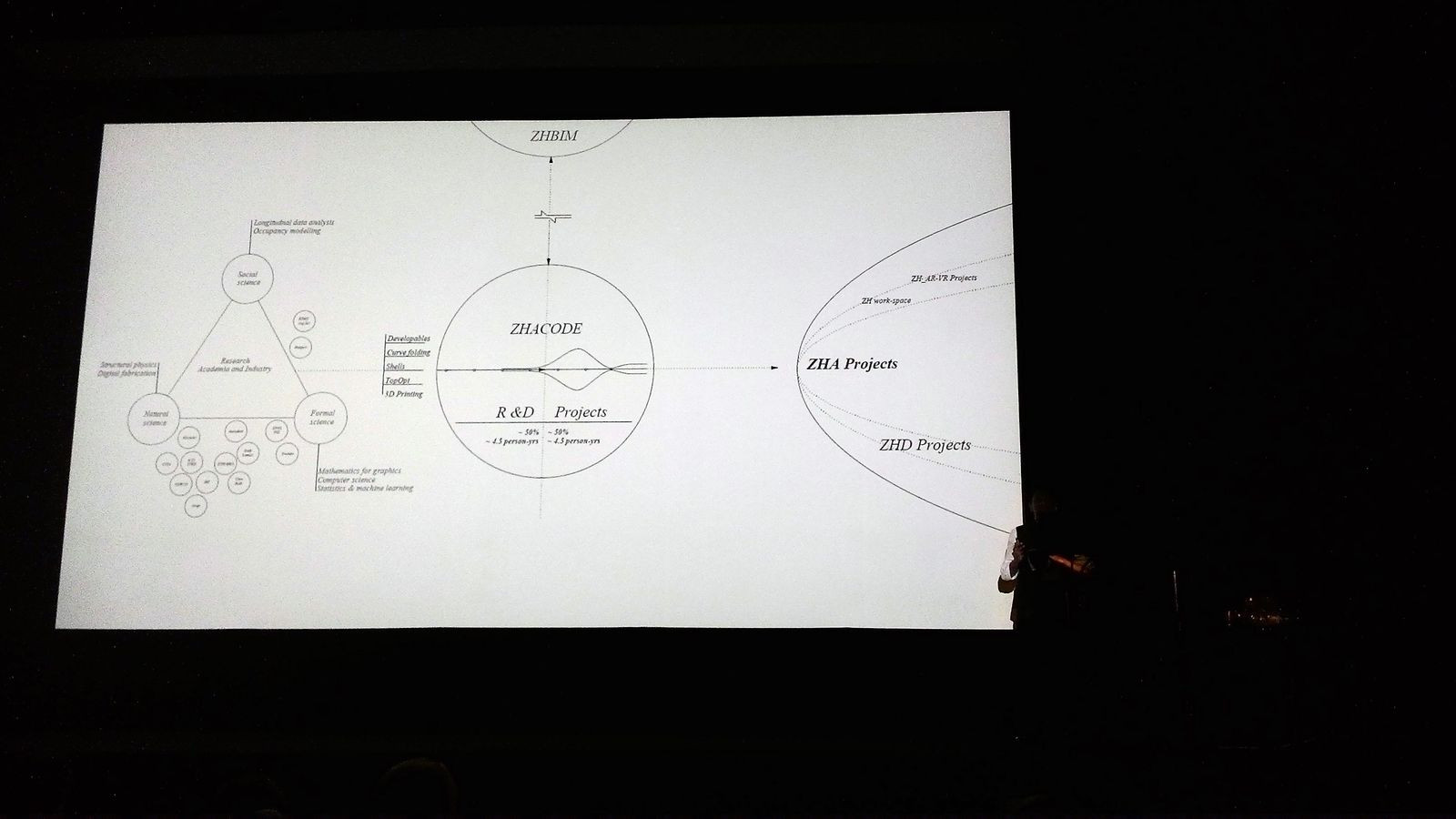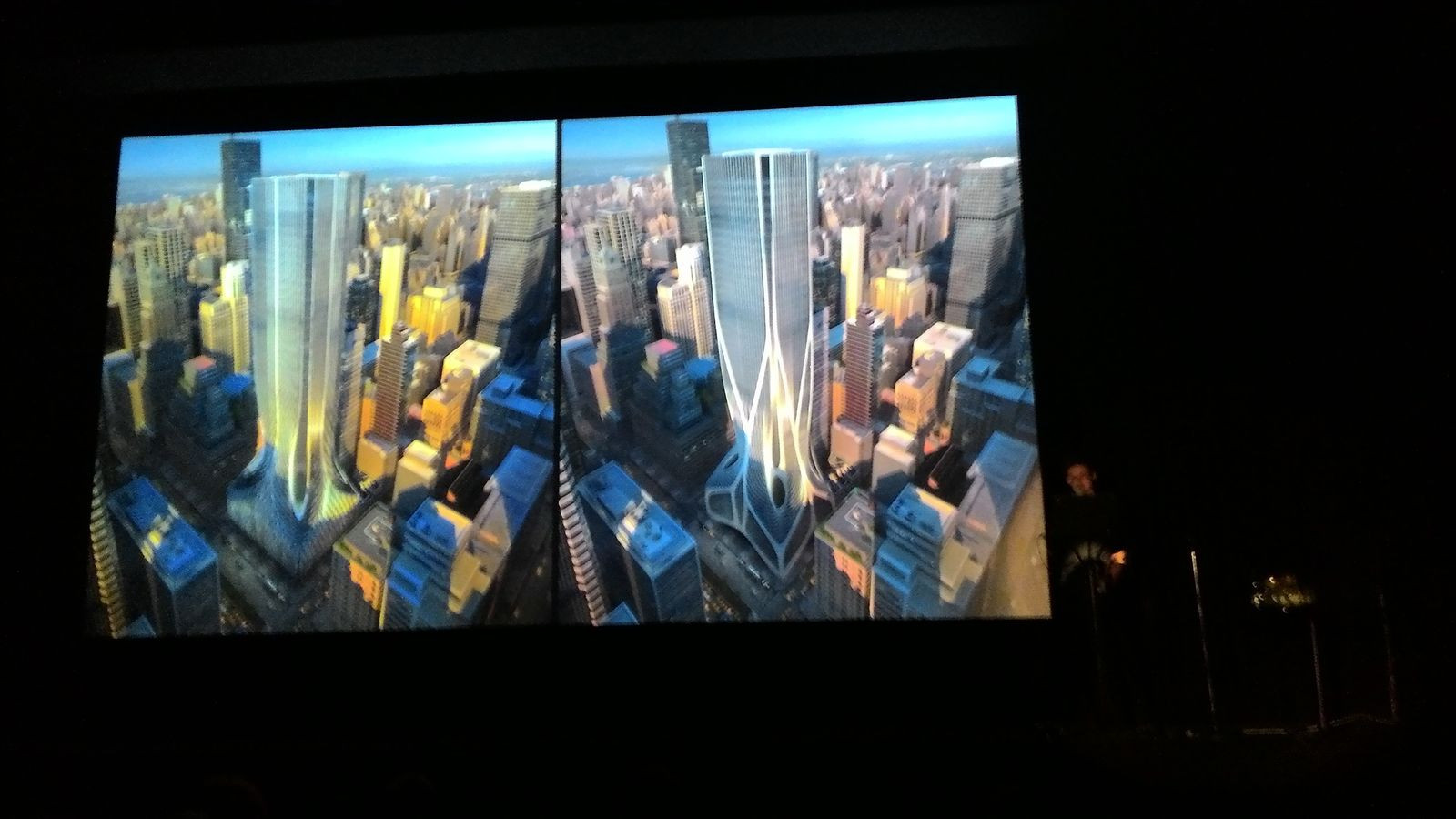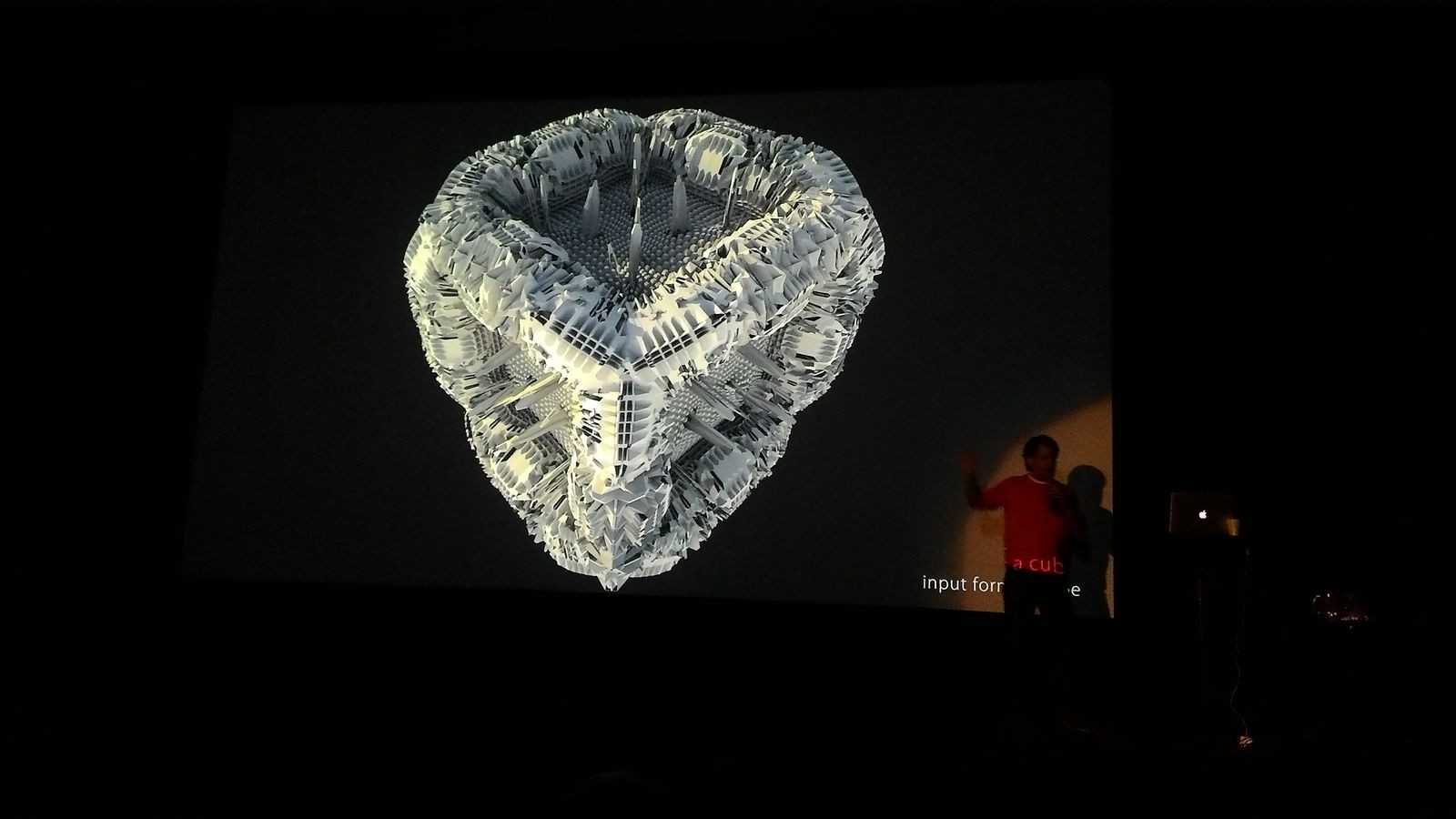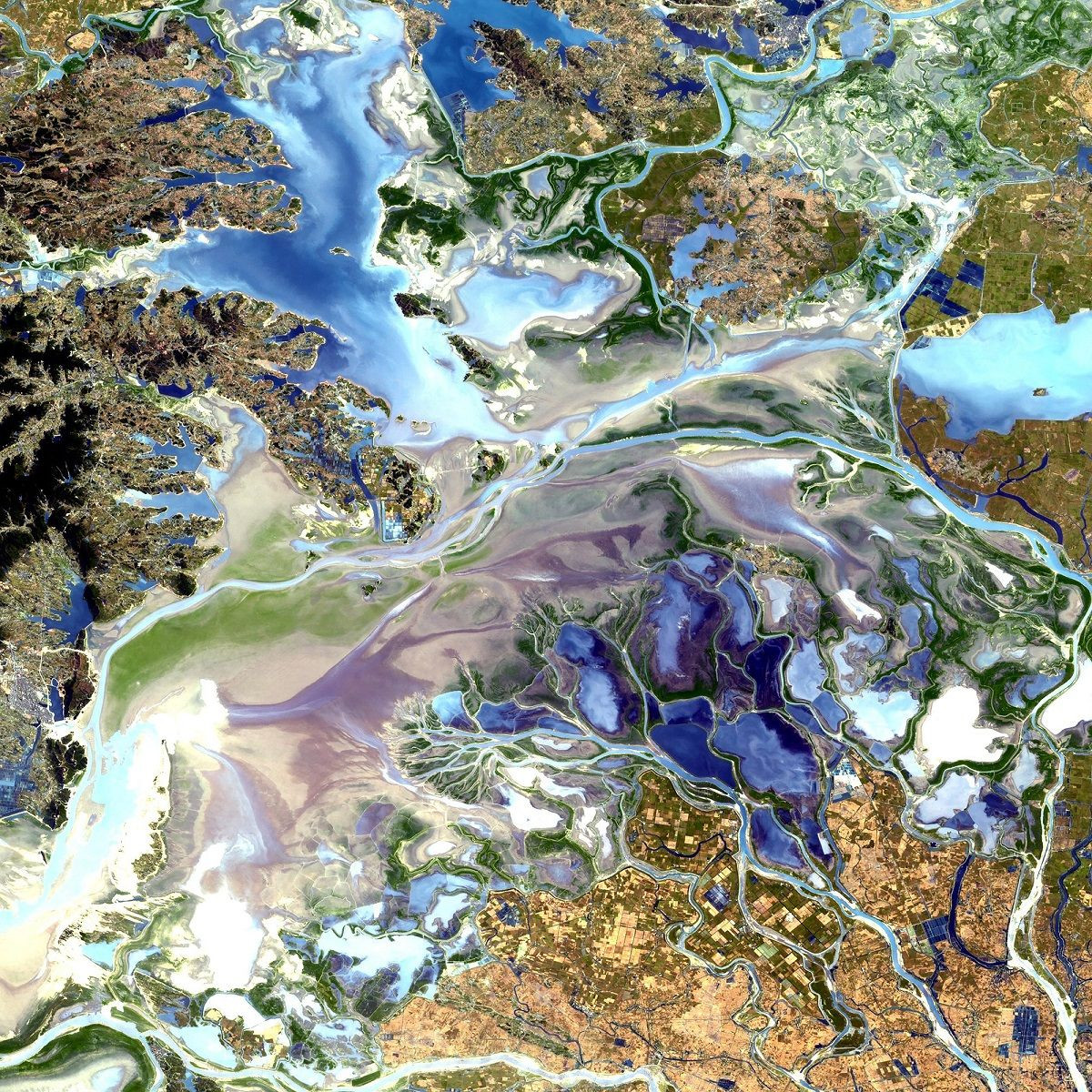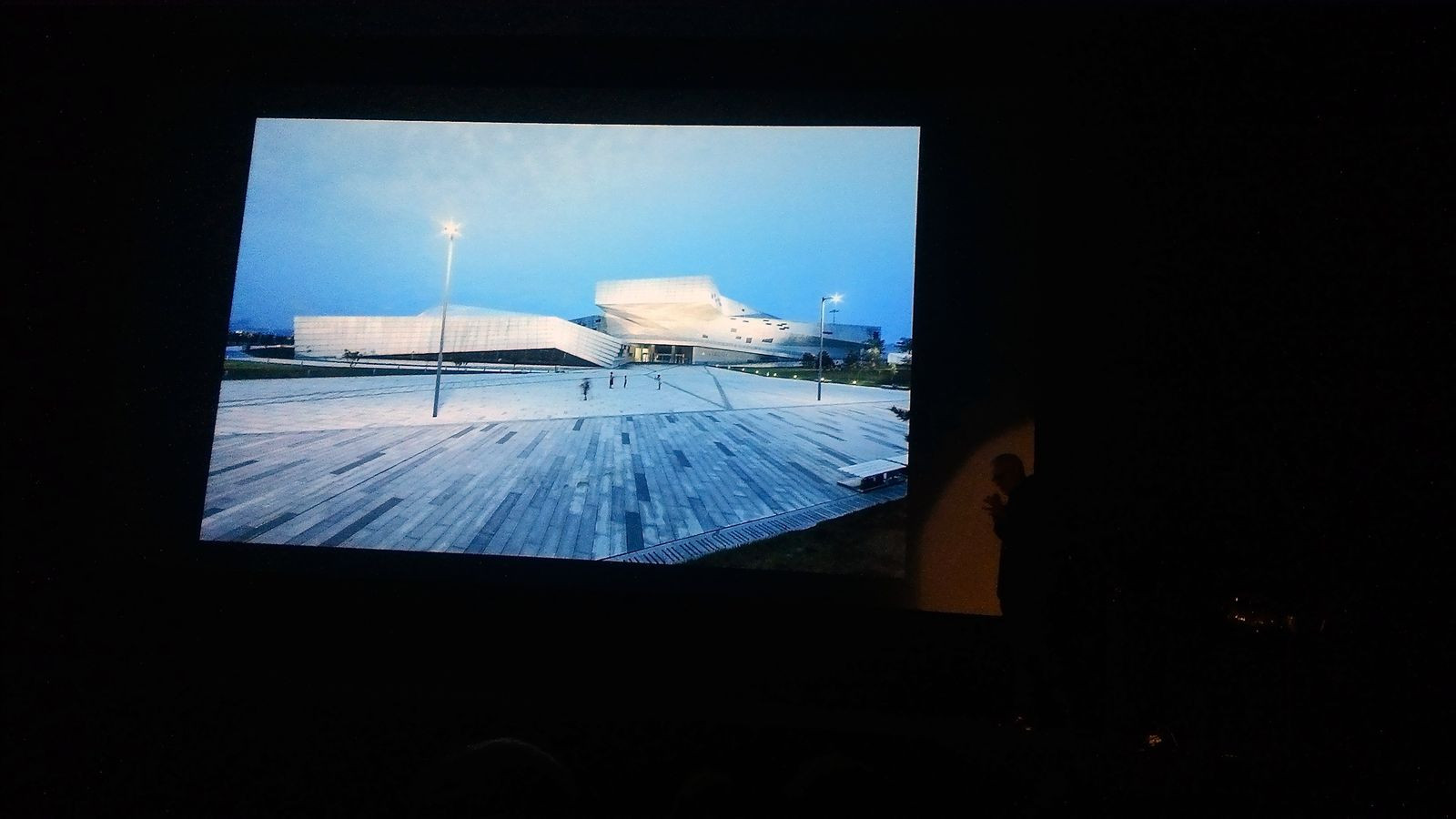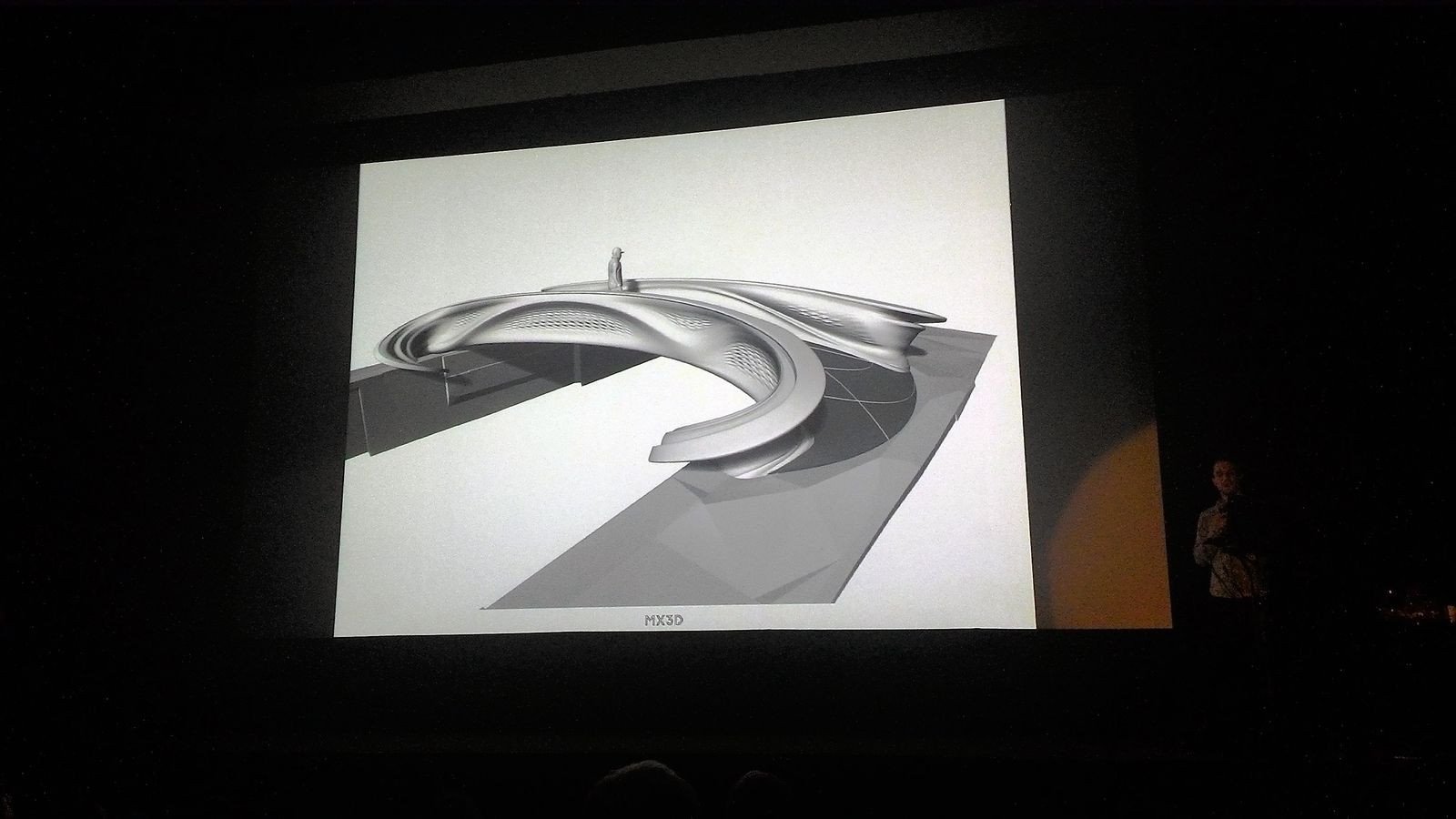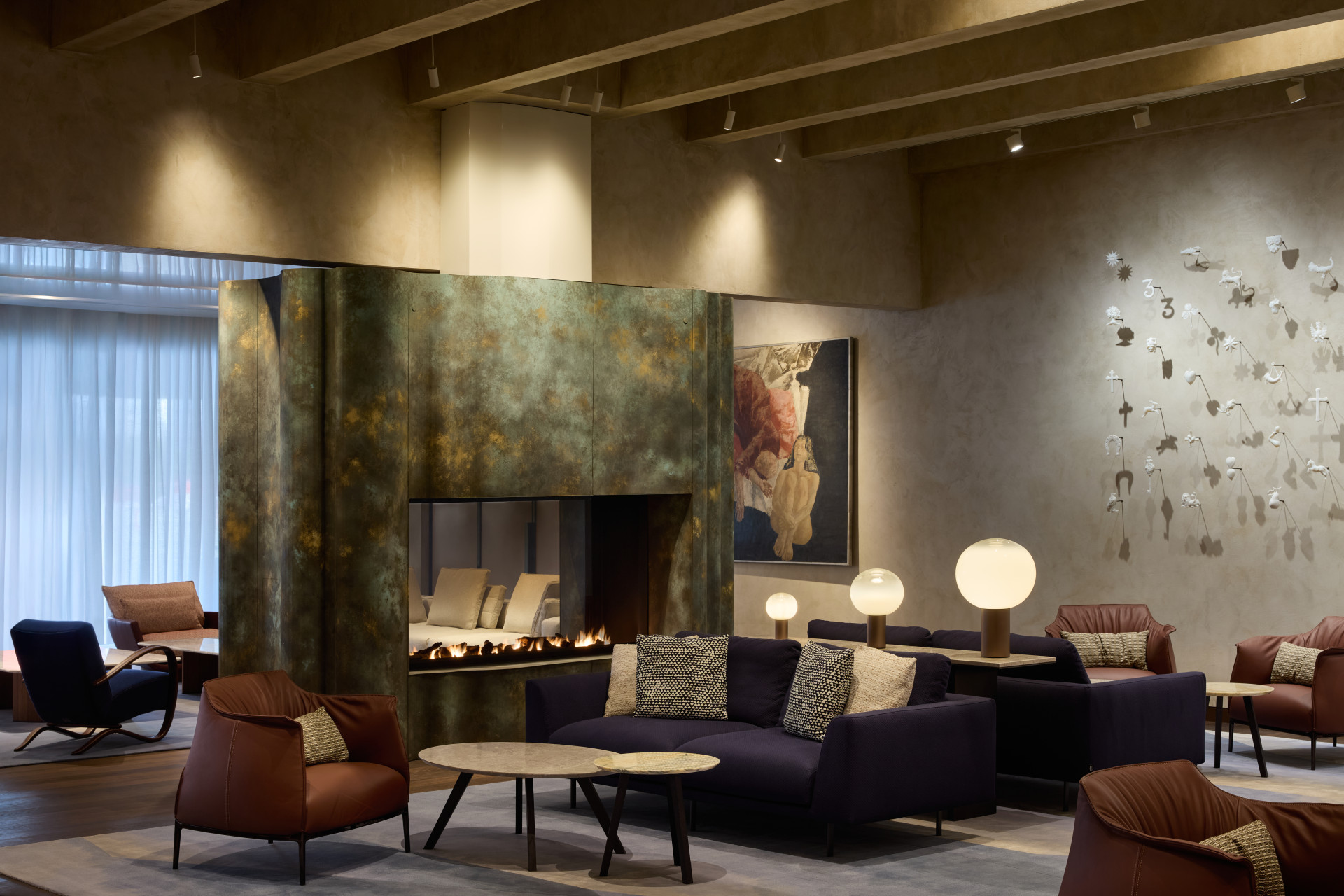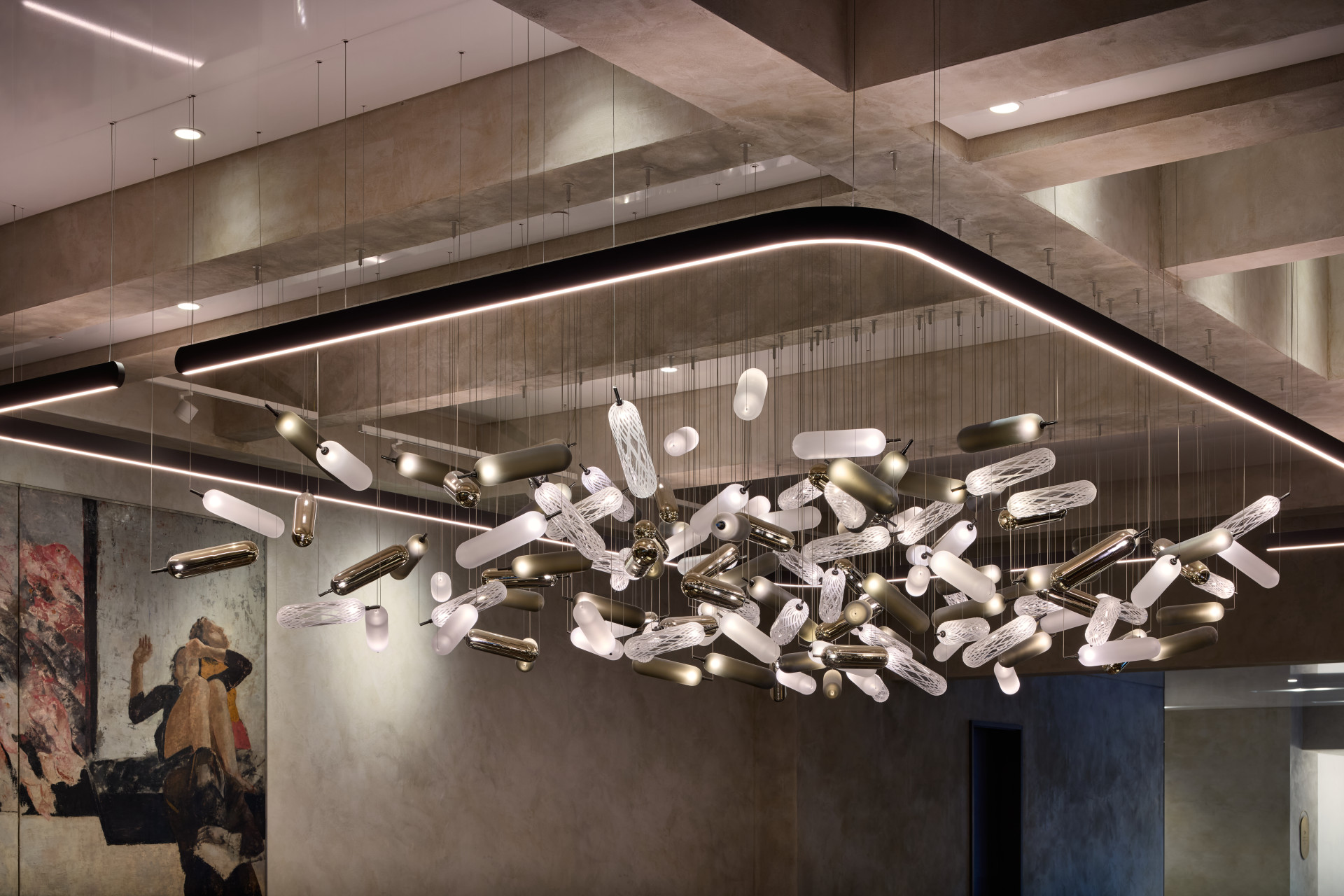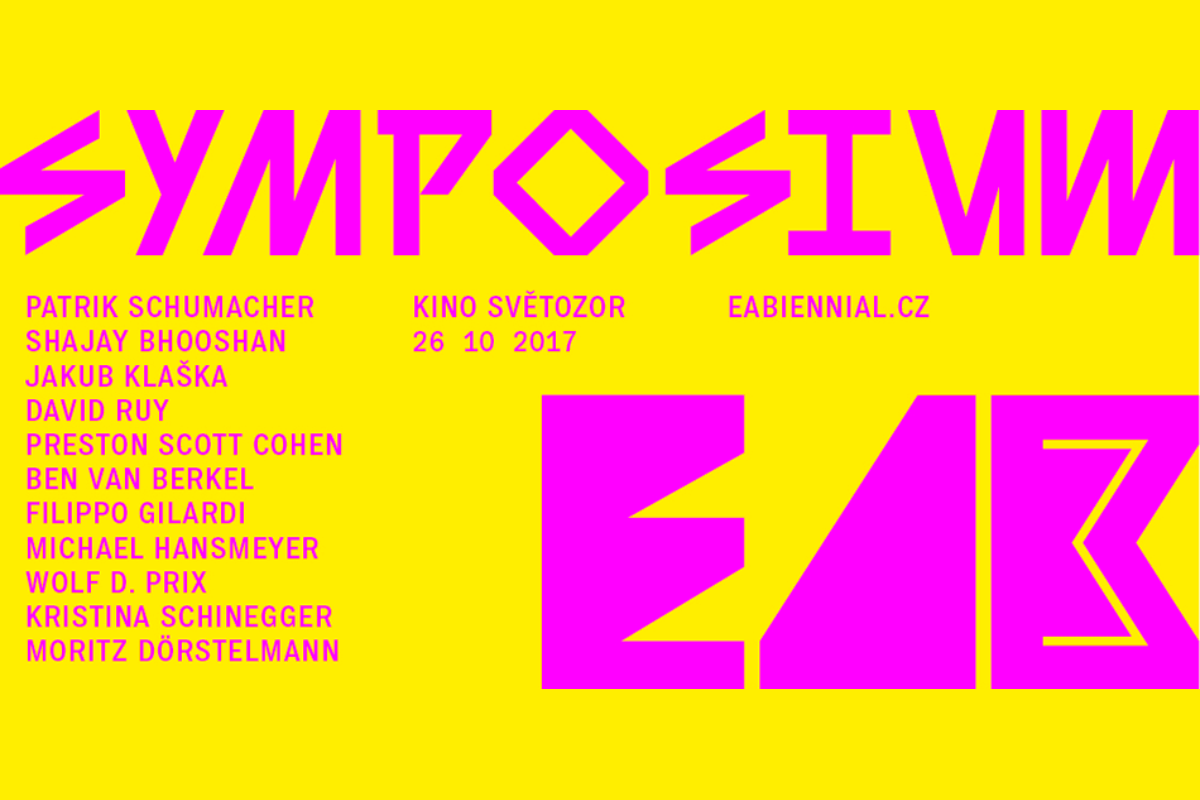
Experimental Architecture Biennale 2017 Prague - Symposium reflections
The 3rd Experimental Architecture Biennale has taken place again in Prague. This time the set of associated activities spanned a time period of almost two months. Main initiators are Imro Vaško, Martin Gsandtner, Dan Merta, Klára Pučerová, Ondřej Pokoj, and Gallery Jaroslav Fragner - obviously with many more people involved.
Henri Hubertus Achten , 28. 10. 2017
Throughout the period the following activities were organised:
Exhibition "Academic Platforms of Design Computation" at UMPRUM (6 September - 7 October). "Meetup Praha" conference at UMPRUM (6 September). Exhibition "Zaha Hadid Architects: Unbuilt" at Gallery Jaroslav Fragner (8 September - 27 October). "Experimental Architecture Biennale Symposium" at Kino Světozor (26 October). Several workshops and installations, "Grotto 4.0," "Hacking Paper," and "Meta Matter."
The Symposium
The symposium on Thursday 26 October brought together a wealth of international architects and theorists speaking on experimental architecture. Unfortunately, Ben van Berkel of UN Studio could not make it - a pity, I was really looking forward to his lecture.
Patrik Schumacher / Zaha Hadid Architects
Patrik Schumacher kicked off a block of three Zaha Hadid Architects speakers, followed by Shajay Bhooshan and Jakub Klaška. The central thesis of his presentation was how "Parametricism" is the over-arching style of contemporary architecture. He distinguished between four subsidiary styles that were used in ZHA: Foldism, Blobism, Swarmism, and Tectonism. He argued how this style forms the backbone in the work of ZHA. The presentation was well-done and delivered with passion, I was quite impressed by it.
Více k tématu

Patrik Schumacher/ZHA presentation. Work shown in the photos copyright of the associated author.
My note: In my view, reducing a profound principle as parametric thinking to an architectural style results in a reduction of the implications of parametric thinking that ultimately is an ill-service to architecture. Parametric thinking - understanding the world as a system of relationships - goes way beyond a prescribed set of appearances; as a style does. Whereas parametric thinking includes non-formal aspects, Parametricism as style is focused dominantly on form. For buildings it works fairly well, but you can see how it breaks down on the urban level, where politics, stakeholders, power-balances, economy, sustainability, and so on are at least as important (or more) than formal considerations.
Shajay Bhooshan / Zaha Hadid Architects CODE
Shajay Bhooshan gave a lot of insights into the core team that works in ZHA on scripting and coding architecture: ZHACODE. Their task is to research, develop, and apply in the projects computational technologies, so that work proceeds efficiently and fast. This involves a lot of research and experimentation, but always within the set boundary conditions of the firm. His presentation was very clear and modest, and gave good insights how research can be implemented in an architect's office.
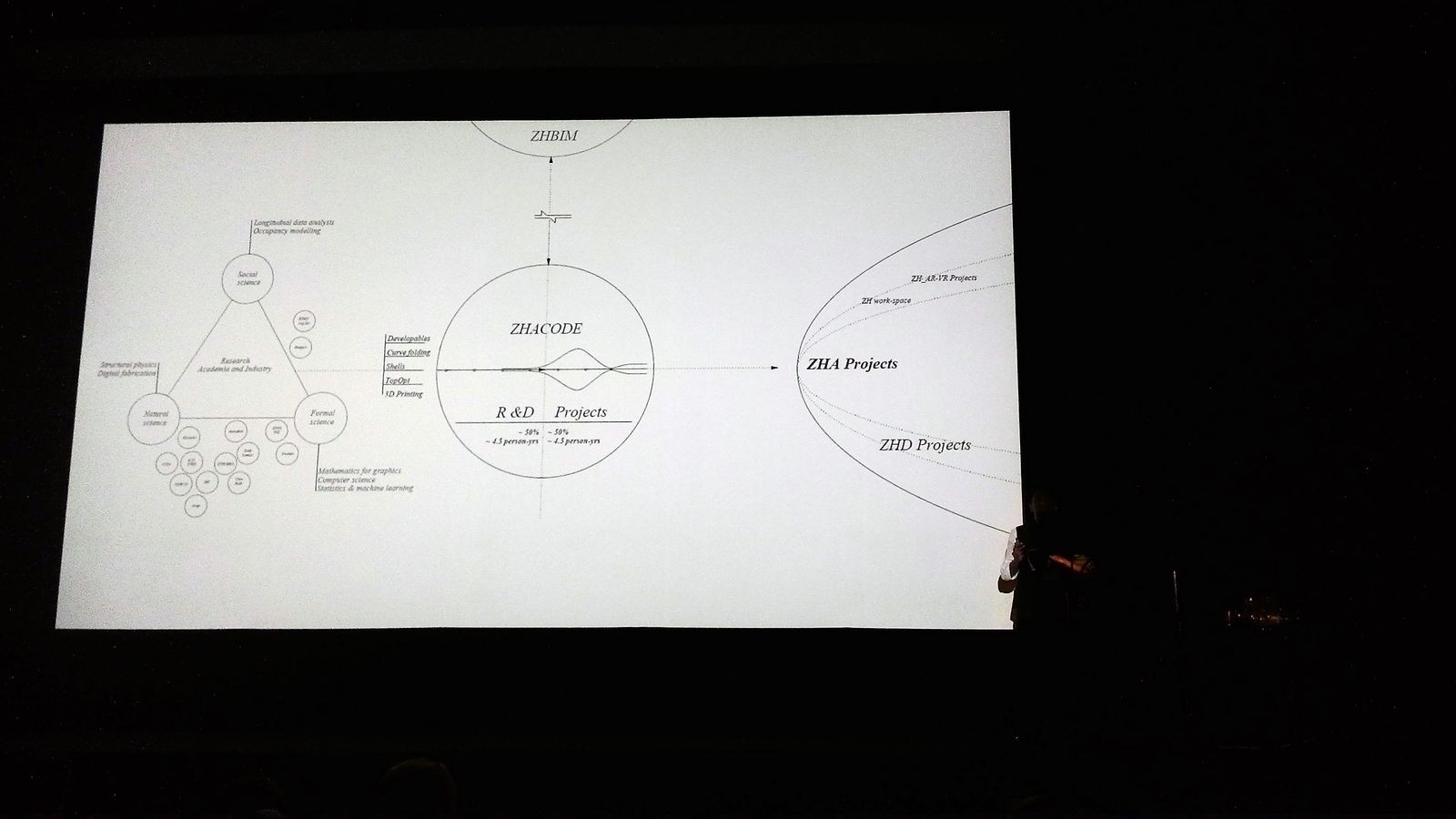
Shajay Bhooshan /ZHACODE presentation. Work shown in the photo copyright of the associated author.
My note: Quite a lot of the larger architectural firms (ZHA, KPF, SOM, Sir Norman Foster and Partners, and so on) have specialised "code"-groups that work as task-force on many projects. I think it is only a matter of time when the distinction between "lead"-architect and "code"-group disappears, because the specialised skills in such groups have de facto become part of the architectural language.
Jakub Klaška / Zaha Hadid Architects
Jakub Klaška presented the exhibition "Zaha Hadid Architects: Unbuilt" held at Gallery Jaroslav Fragner in Prague. The exhibition brought for the first time in Prague together a large number of not-realized projects by ZHA. The focus on the unbuilt projects was very helpful to showcase a wider spectrum of architectural thinking in ZHA office. He organised the presentation alongside a selection of keywords that were instrumental in the structure of the exhibition.
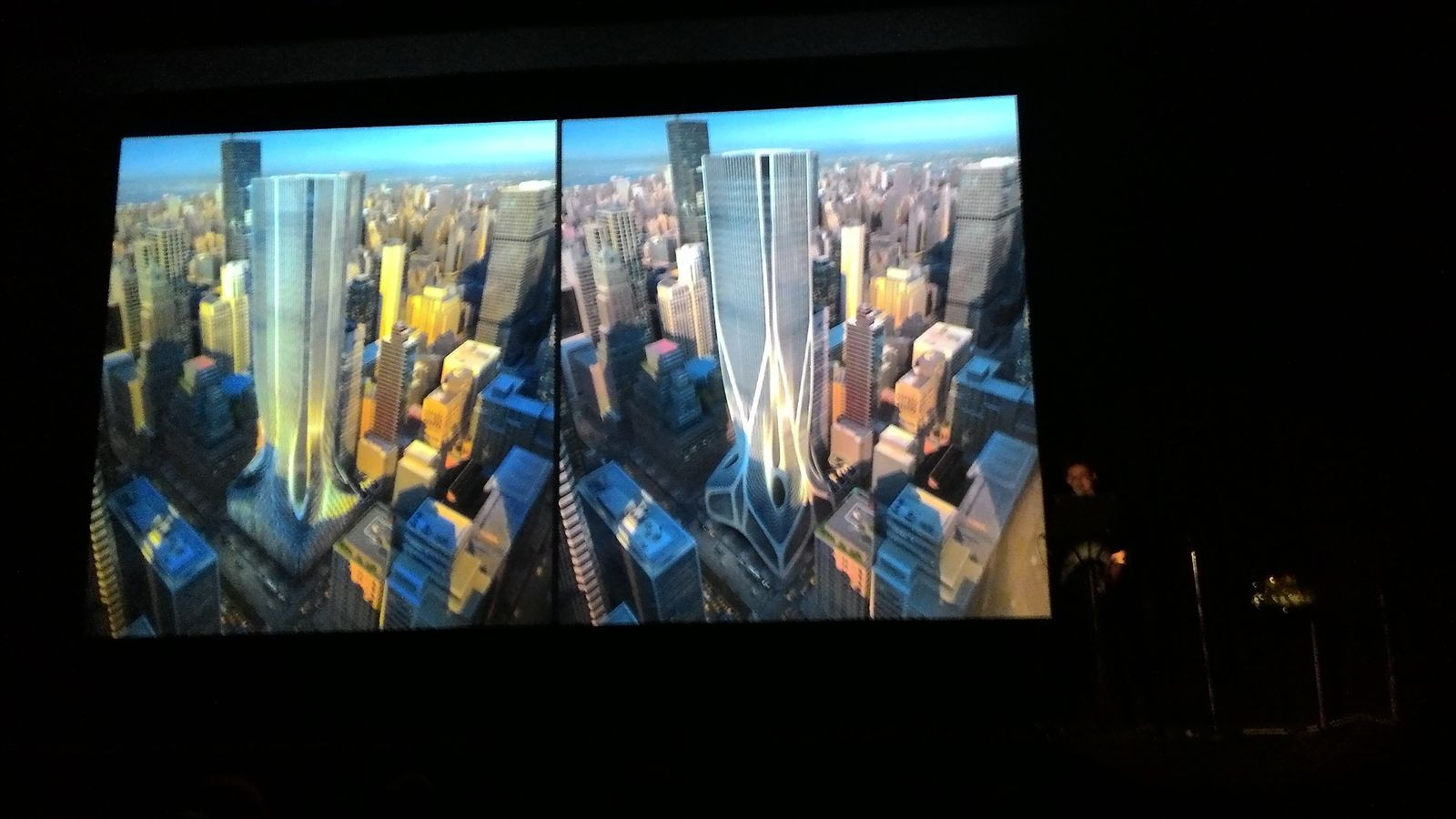
Jakub Klaška / ZHA presentation. Work shown in the photo copyright of the associated author.
My note: I found it rather striking that the main categories mentioned by Patrik Schumacher - Foldism, Blobism, Swarmism, and Tectonism - were not used in the structuring of the exhibition. I guess this points to the importance of fluidity of terms in architectural discourse. In this sense, architecture surely is not like science. In science, consistent use of terms is very important. In the architectural design process, words are drivers of thought. The moment words become fixated, the process also tends to become fixated. So there is a natural tendency to keep meanings open-ended and switch interpretation as frames change.
Michael Hansmeyer/Michael Hansmeyer Computational Architecture
Michael Hansmeyer showed his work on "Columns" and "Digital Grotesque" and showed how these derived from a systematic inquiry into geometric computation. He spent also considerable attention to the realisation part, and the affordance of materialisation. For me, this was the best example of experimental architecture presented at the Symposium - it was very focused, systematically conducted, and brought into reality.
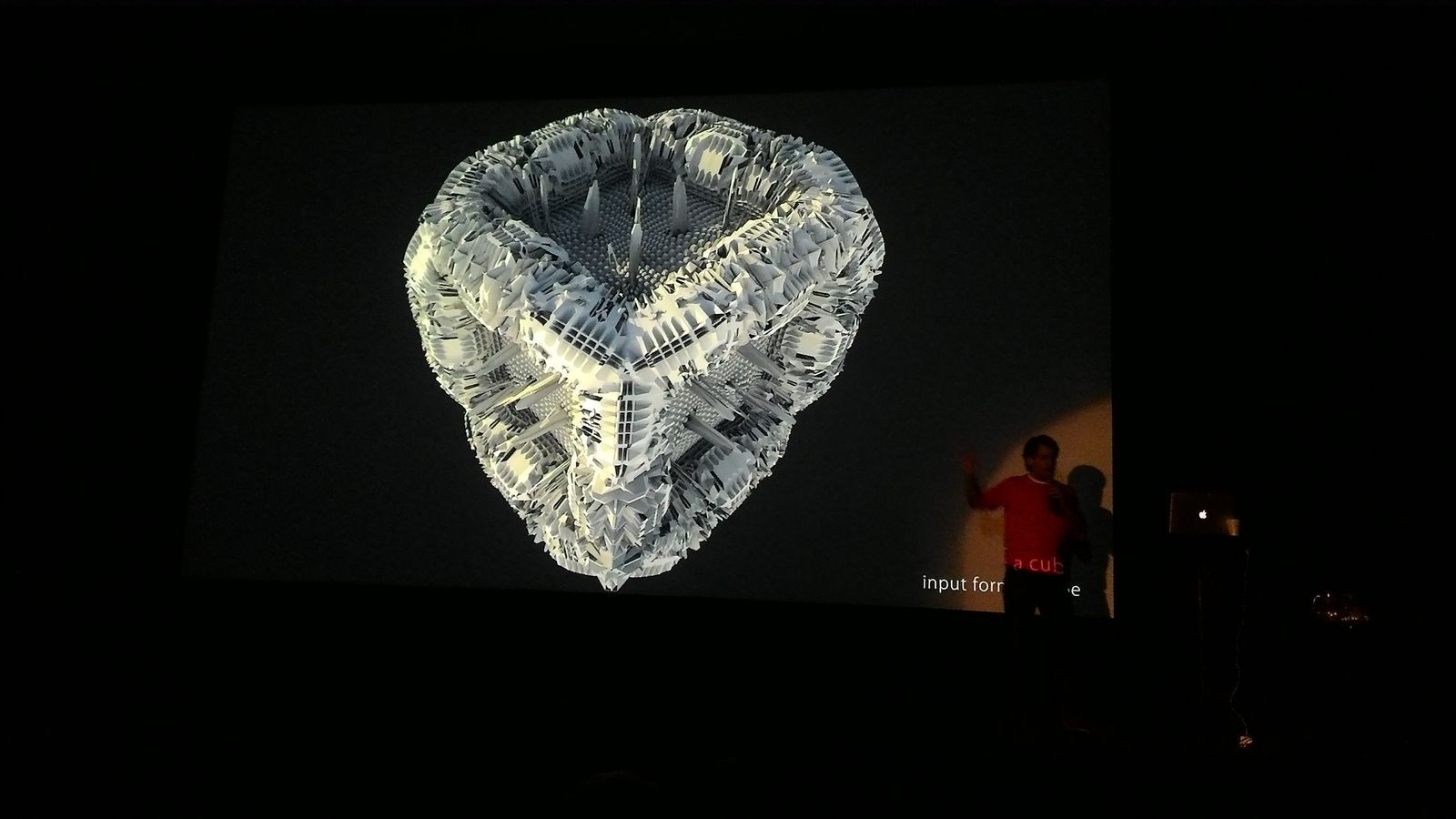
Michael Hansmeyer/Michael Hansmeyer Computational Architecture presentation. Work shown in the photo copyright of the associated author.
David Ruy / Ruy Klein
For me, this was by far the best presentation in the symposium. As David Ruy admitted himself, a bit rough at the edges, but full of challenging ideas and observations about contemporary technology and culture. David Ruy started with an investigation of the image and ended with semi-automated generated avatars and virtual environments. The way he investigated the issues himself and with his students was very inspiring indeed.
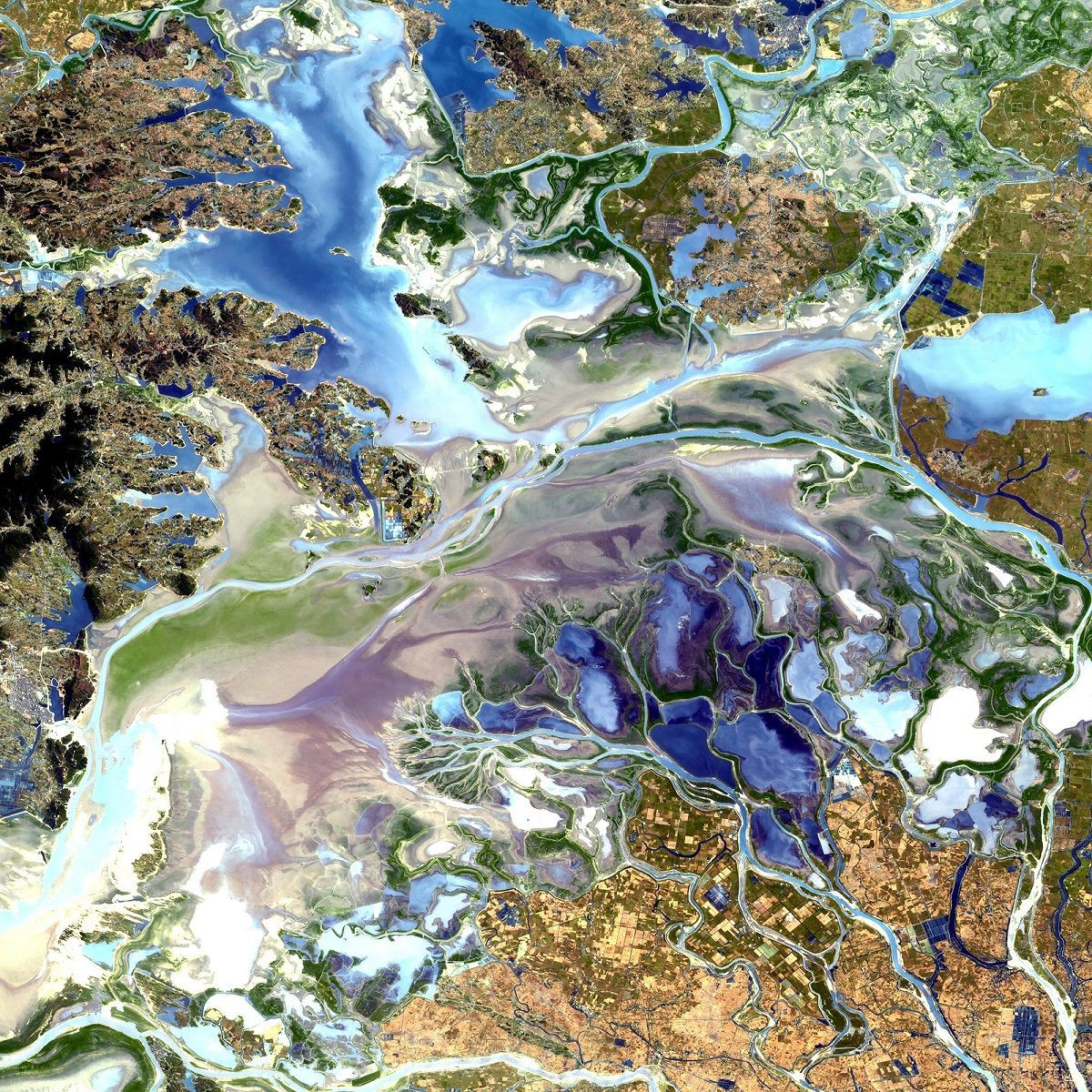
David Ruy/Ruy Klein presentation. Work shown in the photo copyright of the associated author.
My note: Artificial Intelligence did not feature a whole lot in the presentation, except for David Ruy's presentation. His extrapolation from digital image capturing to avatar generation was particularly noteworthy, also in connection with the office shown in the image above. Digital image capturing goes way further than traditional photography (or heliography as David would have it), and it goes even further than contemporary meaning-giving of images through narratives. What happens, is that computers do not make narratives but models. This implies that images become an inseparable part of the information stream between machines, and man and machines. What that entails, is unimaginable right now, but will go further than simple and innocent replication.
Preston Scott Cohen / Preston Scott Cohen, Inc.
Preston Scott Cohen started out with an interesting premise; can, and if so how, architecture be an act of resistance? For art such acts are clear, and are a defining aspect of art, but for architecture this is much more difficult, and maybe even impossible. In the first part of his presentation he investigated this notion, and I thought it was very interesting. The second half moved more towards a traditional portfolio presentation and lost the critical impulse of the first half.
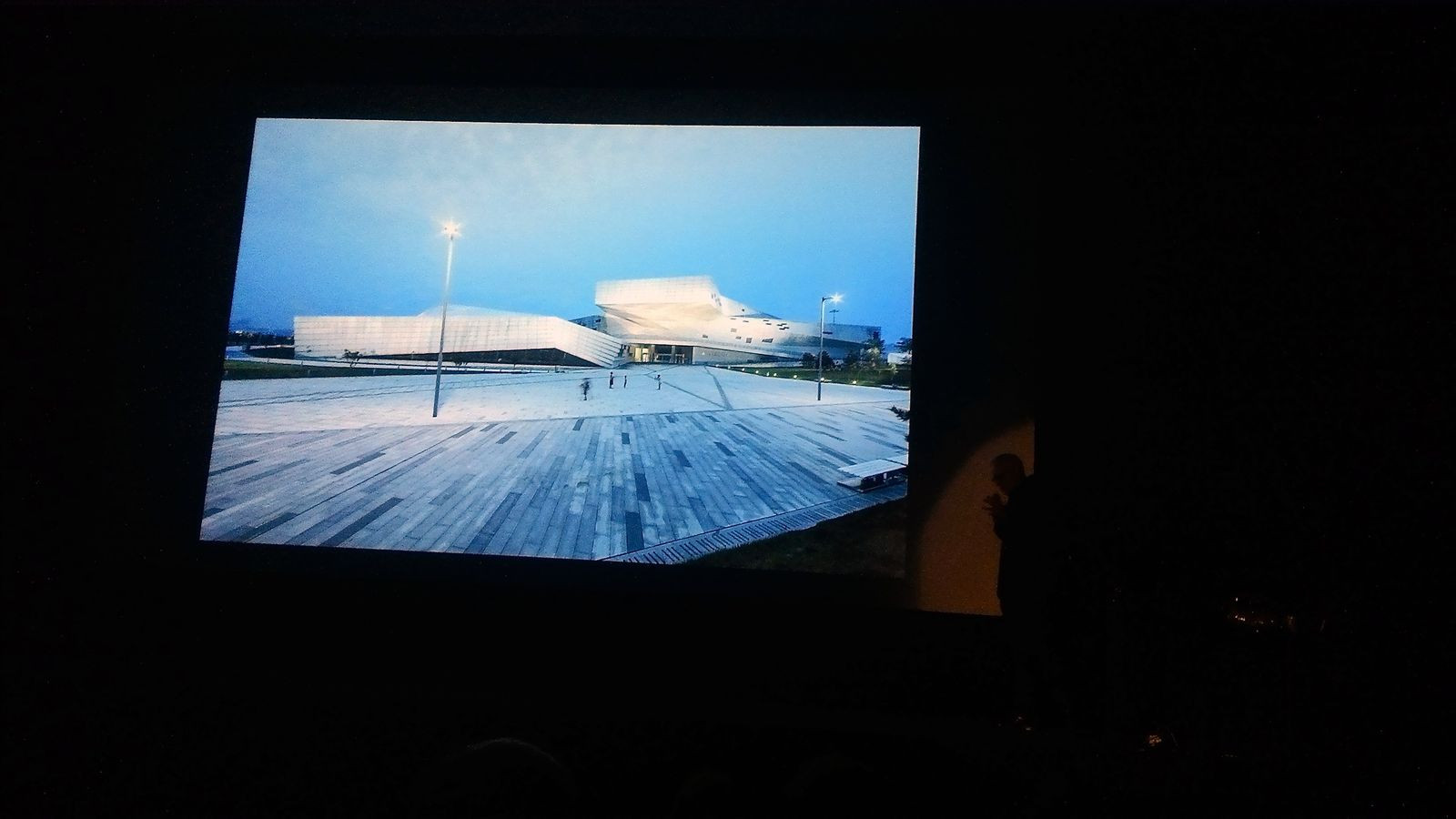
Preston Scott Cohen/Preston Scott Cohen, Inc. presentation. Work shown in the photo copyright of the associated author.
Filippo Gilardi / MX3D
MX3D is a young firm specialising in innovative and experimental production techniques to rethink traditional products. Among an overview of many previous projects, Filippo Gilardi spent considerable attention to the "self-printed bridge" project in Amsterdam. I liked the presentation quite a lot, and it had a number of funny & serious observations, for example about the importance of viral videos. It was very much a similar hands-on experimentation as shown by Michael Hansmeyer, but it tended to go into many directions.
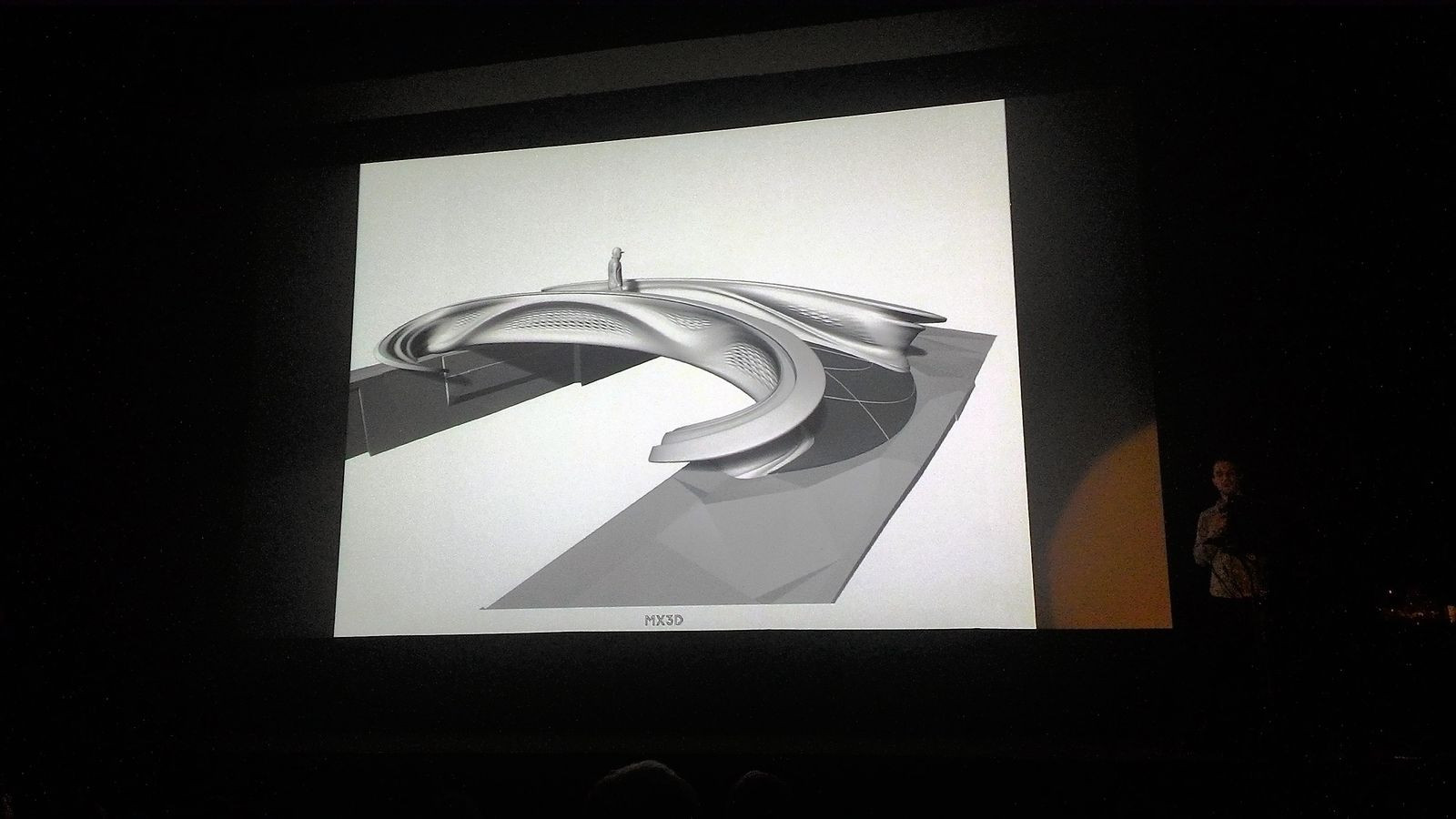
Filippo Gilardi/MX3D presentation. Work shown in the photo copyright of the associated author.
My note: Quite a lot of experimental architects are young companies that face a number of similar problems - creating a reputation is one of them. The self-printed bridge is a rather spectacular way how to solve this problem, and as Filippo Gilardi said himself, one that worked well, but because of its duration tended to become less positive. It generated a lot of positive advertising, but as final realisation kept being postponed, took up resources that could be used for other projects. Another point was the ongoing financial commitment to the project, which in the end leads to diminishing returns. For many young architects and students this was very inspiring (and perhaps sobering) presentation.
Wolf Prix / Coop Himmelb(l)au
Wolf Prix was the star of the symposium. It was evident from everything in his presentation that he is a Master in the true sense of the word. His presentation showcased the work of Himmelb(l)au, touched upon inspirations and problems alike, and also at times was very funny. With an oeuvre that was already experimental in the founding years (1968), he had no need to "prove" anything. The many ups and downs mentioned in the presentation gave a very good insight in the often complicated life of a large and successful architectural office. The struggle with the client was a theme that returned many times in the projects displayed in the presentation. In the Paneum - House of Bread II project (right image below) it also showed the positive effect of a highly involved client. Another interesting aspect of this project was the pragmatic optimization of the facade paneling based on visibility and relating this to the articulation of the panels.
Another important point raised by Wolf Prix was the waste of invested money and time that goes in architectural competitions. Competitions offer rare opportunities for companies to acquire large projects, but it means that there is an incredible surplus of firms that lose the competitions and thus lose their investment in the competition entry. Wolf Prix argued strongly against this mechanism.
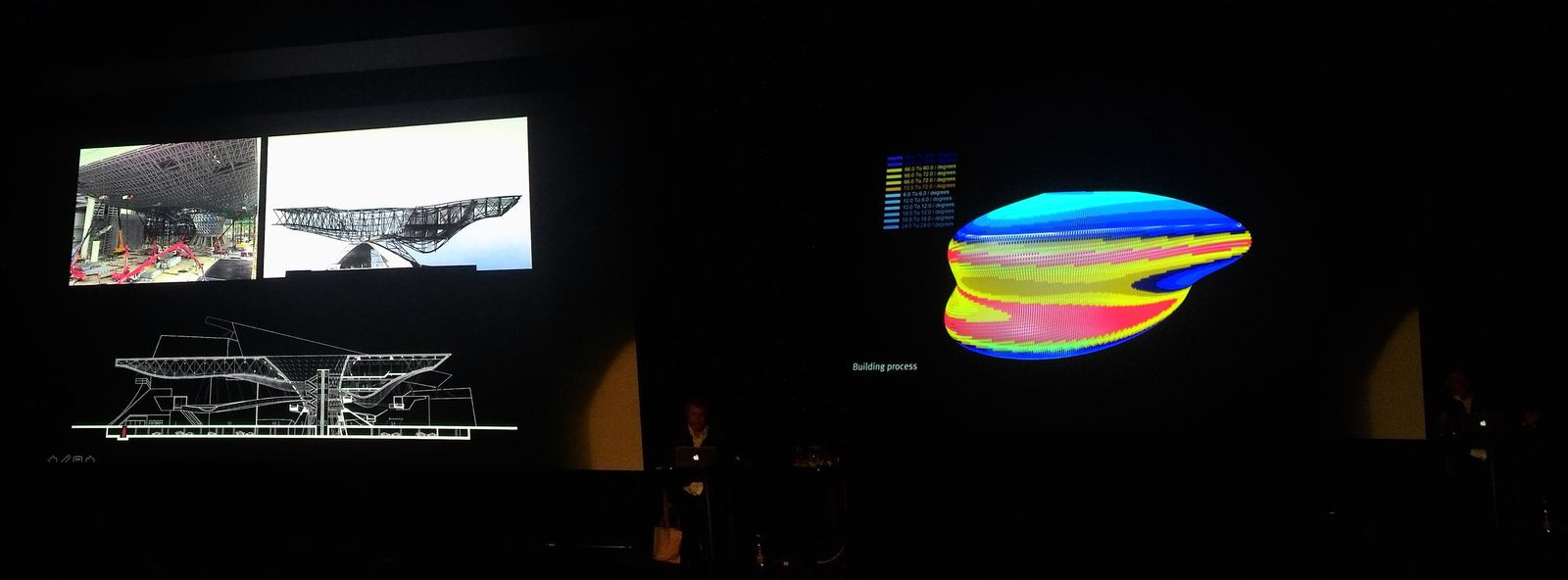
Wolf Prix/Coop Himmelb(l)au presentation. Work shown in the photos copyright of the associated author.
My note: At the question from the audience, "where is it more fun to work, in Europe or in China?", Wolf Prix answered "it is not fun in Europe nor in China." The erosion of the architect's tasks, while keeping the responsibilities, leads to increasing discrepancy between architect's fee and what they actually deliver. This is a very important issue in practice, and one where perhaps experimental architecture may show a way out of. By promoting tightly integrated research-design-realisation practices, experimental architecture can "defend" itself against such tendencies. It still has to resist many tendencies however to keep this status up.
Although for sure Coop Himmelb(l)au is experimental, it is not a contemporary experimental architectural firm. Contemporary experimental firms, as said above, integrate research, design, and realisation. In this sense, Coop Himmelb(l)au still refers to the old image of the genius architect who has an inspiration, and sets out to create this inspiration. Yes, there is research and a lot of development, but it comes after the ideation, and the research is not part of the ideation itself.
Kristina Schinegger / SOMA
Kristina Schinegger showed how important winning competitions is in the formative years of an architectural office. They won the competition for the theme pavilion Expo Yeosu in Korea, which was the actual impulse to start their own office. Later they also won the temporary art pavilion in Salzburg. She traced a number of projects realised in the office, and showed how design and investigation go hand in hand.

Kristina Schinegger/SOMA presentation. Work shown in the photos copyright of the associated author.
Moritz Dorstelmann / FIbR GmbH
Moritz Dorstelmann was the last speaker at the Symposium. He has been involved in the well-known series of research pavilions created at the Institute for Computational Design in Stuttgart lead by Achim Menges. He started his own firm, FIbr GmbH to use this kind of technology in architecture and furniture design. The presentation featured the series of research pavilions, lessons learned, and how knowledge and skills evolved throughout the years.

Moritz Dorstelmann / FIbR GmbH presentation. Work shown in the photos copyright of the associated author.
My note: Moritz Dorstelmann is a good example of an architect who has matured in an environment - ICD in Stuttgart under Achim Menges - that differs quite a lot from the traditional pedagogical model of the Master-Apprentice that still is dominant in most schools of architecture. Rather than learning the trade, he has learned the coupling between research-design-realisation to inform his design thinking. This approach makes knowledge generation a fundamental part of architectural practice, which is necessary if the discipline is to stand a chance against the pressures from outside that keep taking away tasks and responsibilities.
Final thoughts
There was one striking element missing in this year's symposium: BIM. Shajay Bhooshan showed BIM in his figure (ZHBIM) but did not dwell on it. Michael Hansmeyer talked about BIM as a "means of control, not of design." Despite all the sophistication displayed at the presentations and apparent skill of all the participants, it seems when it comes to BIM, no one knows how to deal with it. BIM is rather deferred than challenged. I think a lot of this has to do not with BIM as phenomenon, but with the way BIM is supported today in software. If the software vendors do not pick up this challenge, then we will see a split where BIM is not going to feature in the ideation process at all. It will become an outsourced activity, much in the same way today rendering is outsourced to specialized companies. This would be to great detriment of architecture as a whole.
So how experimental was the symposium? As I argued above, I think only two contributions were experimental (Michael Hansmeyer and David Ruy). Much of the rest of the work has already become mainstream. Nothing was actually challenged, or, in the words of Preston Scott Cohen, there were no acts of resistance. The advanced techniques are assimilated and a steady stream of formally interesting buildings is being produced. Patrik Schumacher's attempt to catch everything under Parametricism is also an act of consolidation, of claiming a style and securing a piece of the market.
Even so, the presented works show models that can lead architecture out of its decades old and obsolete working mode. Especially the coupling between research-design-realisation has to supersede the Master-Apprentice model. Architecture needs to build its own body of knowledge, and it is high time to speed up this effort.
The bottom-line
The 3rd Experimental Architecture Biennial was more ambitious and larger than the previous editions - and it provided a great venue to showcase state-of-the-art in contemporary architecture in Prague. This is a very important contribution and highly inspiring event. Many compliments to the organisers and everyone involved!




